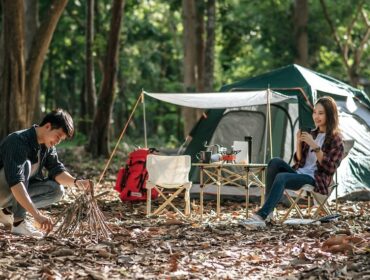Tents aren’t one-size-fits-all. There are different types of tents. A tent that crushes it in the Rockies might flop on a humid beach weekend. Terrain matters. So does climate. And if you’re buying a tent without thinking about either, you’re gambling with your comfort and your gear budget.
This guide walks through how to choose a tent based on where you’re camping and what the weather throws at you. You’ll get expert tips, use-case recommendations, product comparisons, and a buyer-friendly breakdown of best rated camping tents across different environments. Whether you’re car camping in the rain, hiking into the mountains, or setting up near a desert canyon, the right tent can make or break your trip.
Let’s figure out what’s right for your adventure.
What to Keep in Mind When Choosing a Tent
Choosing a tent isn’t just about weather—there are a few other key things to weigh:
-
Weight vs. durability: Lighter isn’t always better. Consider the trade-offs.
-
Setup style: Freestanding tents are more forgiving. Non-freestanding tents are lighter but need perfect staking.
-
Tent seasons: Three-season tents are great for most conditions. Four-season tents are for cold and wind.
-
Size and capacity: A “two-person tent” often means two people without gear. Always size up if comfort matters.
-
Packed size: Consider how much room the tent will take in your car, pack, or bike
Tent Picks by Climate and Terrain
Here’s a quick list of high-performing tents tailored to specific conditions. These are top-rated, reviewed by real users, and recommended by gear experts:
1. Sierra Designs Alpenglow 6 Person Tent

This tent is built for families or groups who want simplicity without sacrificing comfort. It’s completely freestanding, which means no hassle when setting up on hard ground. The pole design uses equal-length poles, so there’s no guessing or sorting. Pole clips snap on quickly, even if you’re pitching in the dark or during a wind gust. The floor is rugged and sealed tight to keep water from seeping in. That means no waking up in a puddle after a rainy night.
Ventilation is handled well thanks to a mostly mesh upper. That helps keep the air flowing, even on warm, sticky nights. The large front door makes getting in and out feel easy, especially when you’re sharing space. There’s plenty of room for kids, gear, or even a four-legged friend. Whether you’re car camping or setting up for the weekend, this tent makes camp life easier from start to finish.
2. Big Agnes Spicer Peak 4 Person Tent

This dome-style shelter feels much bigger than it looks from the outside. Its structure gives you more vertical space to stretch out and move around. Two doors mean no awkward crawling over someone during the night. Each vestibule offers a dry spot to stash shoes or bags. Everything is color-coded—from webbing to buckles—so setup is straightforward even on your first try.
Inside, it’s cozy but never cramped. The freestanding design gives you options on uneven ground or when stakes aren’t ideal. It’s a great fit for small families or friends heading into the woods. Durable materials and smart layout make it a dependable choice for weekend camping. If you’re after a practical tent with simple features that work, this one delivers.
3. Nemo Aurora Highrise 6 Person Camping Tent

Tall campers, rejoice—this one gives you room to stand. The near-vertical walls make it feel more like a cabin than a tent. That extra headroom makes getting dressed or moving around way easier. With dual vestibules, you’ve got spots to stash gear without cluttering the inside. The aluminum poles give it serious strength, so it holds steady in wind and rougher weather.
Setup and pack-up are both smooth. It comes with a big duffel bag that actually fits the tent—no wrestling required. Inside, small touches like Nightlight Pockets offer warm, soft lighting after sunset. This tent feels like a true basecamp, perfect for longer trips or big families. It turns campgrounds into home, and rainy weekends into no big deal.
4. Marmot Limelight 3 Person Tent

Inside feels much roomier than expected, especially when you sit up or shift around. The headroom gives you freedom to move comfortably. The extra-wide door means less twisting and turning while getting in or out. Two vestibules on either side keep gear dry and out of the way. The layout works well whether you’re solo, with a buddy, or even with a pet.
You can pitch this tent almost anywhere, thanks to its freestanding design. Interior pockets make it easy to stay organized—no more fumbling for a flashlight at 3 a.m. It’s dependable, quick to set up, and built to handle varied conditions. A solid choice for anyone who camps a lot but still wants comfort.
5. The North Face Stormbreak 2 Person Tent

This tent feels thoughtfully built, especially if you’re sharing space. Two doors mean you both get an exit without disturbing each other. The twin-zip vestibules give you flexible storage and quick access. The ventilation system is simple but works well. High-low airflow cuts down on condensation and keeps things fresh.
It’s built tough with a seam-taped canopy and floor that keep out water. No flame-retardant coating either, which is better for the planet and your lungs. Inside, doors tuck neatly into mesh pockets so they’re not flapping or in the way. It’s a dependable option for couples or solo adventurers looking for a tent that does more with less.
Each of these performs best in its own element. Pick one that matches your terrain—not just your wishlist.
How to Take Care of Your Tent
Treat your tent right, and it’ll last for years.
-
Dry it before you pack it. Always. Mold ruins tents fast.
-
Use a footprint or tarp to protect the floor from sharp rocks or water.
-
Store it loosely in a breathable sack and not tightly rolled in its stuff sack.
-
Clean it with cold water and a soft sponge. Skip detergents or chemicals.
-
Check the seams occasionally. Re-seal if needed.
Take care of your shelter, and it’ll take care of you.
Final Thoughts
Knowing how to choose a tent isn’t about chasing the most expensive model – it’s about matching your gear to your environment. The right tent handles heat, wind, rain, or snow without slowing you down or cutting your trip short.
Think about where you’re going, what the weather looks like, and how much space you need. Whether you’re camping solo in the mountains or car camping with family, how to choose a tent comes down to comfort, setup ease, and weather protection. Stick to that, and you’ll always have a solid shelter waiting for you at the end of the trail.
FAQs on How to Choose a Tent
What’s the difference between a 3-season and a 4-season tent?
Three-season tents are great for spring, summer, and fall. Four-season tents are built for winter and extreme wind.
Do I really need a footprint under my tent?
Yes. It protects your floor, extends your tent’s life, and helps keep water out.
Can I use a backpacking tent for car camping?
Sure, but it won’t be as roomy or comfy. Use it if you’re short on space or already own one.
How do I stop condensation inside my tent?
Ventilate well. Open vents, crack the door, and don’t cook inside. Moisture from breath needs somewhere to go.
Should I choose a tent with one door or two?
If you’re sharing your tent, go with two doors. No one likes being climbed over at 2 a.m.





